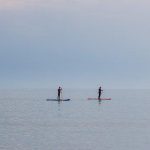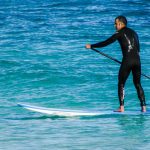The chances are good that you have heard of stand-up paddle boarding. You may not know about it, but SUP yoga is gaining popularity, as are other SUP hobbies like touring. So what is all the excitement about?
SUP is one of the fastest-growing water sports in the world due to its popularity in both low-key beach towns and small waterways in bustling big cities. Pro athletes use it to cross-train, while casual paddlers use it to catch up with friends while getting out on the water.
What is Paddleboarding?
Stand-up paddleboarding is a watersport where people use a paddle to move themselves forward on a paddleboard while standing up (or sometimes kneeling).
A Good Workout
Stand-up paddleboarding is an excellent workout that works your upper body, legs, and core. It is also low-intensity and fun. You should skip the gym and go to a nearby lake to paddleboard.
Very Simple Exercise
The great appeal of stand-up paddleboarding is its simplicity. It is easy enough that anyone can give it a try, regardless of their body type, shape, or fitness level. Just two years before she made history as the only person to travel the entire length of England through
its canal systems, Lizzie Carr tried paddleboarding for the first time. Carr is quoted as saying “I’m on a mission to show that anyone can have an adventure.
What I’m doing is something anyone can do.” This just goes to show that with paddleboarding, almost anyone can have an amazing experience.
Burns Loads of Calories
How many calories you burn while stand-up paddleboarding depends on how active you are while doing it. The more you go at it, the more you’ll burn.
But even a casual pootle can churn through 430 calories in the space of an hour, according to SUP World Mag. That’s about double the figure you’d burn on a moderately-paced walk over the same period.
Upgrade your stand-up paddleboarding session to a yoga workout, and you’ll get through 540 calories in an hour, while an hour of SUP touring (paddling for a distance without stopping at a moderate pace) will burn 708 calories, the same level as SUP surfing (like actual surfing, in the sea, but with a paddle).
Great for Your Core
This is a great way to work on your core muscles without having to do a difficult exercise like a plank.
Your abs will be constantly working to help you keep your balance while you are paddleboarding, which is a more gentle and fun core exercise than something like a seated barbell twist.
“The rockier the water, the harder you have to work to stay upright and balanced, which is great for your core,” says Nicky. “It’s great for a flat tummy, too – I’ve never had a six-pack before, but it’s coming.”
Builds All-Body Strength
Paddling on a SUP board is great for working multiple muscle groups at once. It requires coordination and balance, engaging the quads, shoulders, arms, and knees.
The core muscles also have to work hard to keep you stable. Even though it is a lot of work, it is also enjoyable because you are moving across the water.
This makes it a perfect exercise for people who want both aerobic and strength-based training.
What Are the Benefits of Paddleboarding?
Paddle boarding is great for many reasons. One reason is that it is a great workout because of its holistic benefits. SUP also has a meditative quality that comes from the ability to see the world in a slower, more detailed way.
Paddle boarding is also great because it allows you to immerse yourself in the natural landscape and appreciate your setting from a fresh perspective.
Stress Reliever
The SUP experience takes place in nature, where you can enjoy the sun and meet marine life face-to-face, which are both great ways to relieve stress.
One great thing about SUP is that it is often done in a group, so it is a great opportunity to bond with your children, friends, and family. Also, it is very enjoyable!
If you’re looking for a workout that won’t leave you feeling exhausted and sore afterward, try SUP (stand-up paddle boarding). It’s a great way to get in shape without the intense effort of other strength-based workouts, and it’s also easier to master than something like skiing or surfing.
You can make it as easy or as difficult as you want (depending on factors like the current and speed), but it’s a good choice for anyone who wants to ease into exercise gradually.
Plus, the open landscape is beautiful and relaxing, and you can jump in the water for a refreshing break whenever you need it.
Stand-up paddleboarding immerses you in nature
Stand-up paddle boarding is about more than just exercise; it’s also about escapism. You get to immerse yourself in nature, with the sun on your shoulders and water stretching out all around you.
It’s a rich and immersive experience that can bring you face-to-face with the meditative delights of Mother Nature.
Lets You See the World at Your Pace
Stand-up paddleboarding is a great way to get a full-body workout while seeing the world from a new perspective.
You can use it to travel to new places and see things you wouldn’t be able to see from land. It’s a great way to appreciate the natural beauty of the planet and spot wildlife.
Comes With the Perfect Cool Down
We love stand-up paddleboarding because it’s a great workout and it’s also very relaxing. You can paddleboard anywhere in the world, and the conditions will always be different, so you’ll never get bored.
And when you’re done with your workout, you can just lie down on your board and soak up the sun.
Is Paddleboarding Difficult?
Balancing on a paddle board may seem daunting at first, but with a little practice, anyone can do it! If you already know the basics of paddling, why not invite a friend who’s never tried it before to come along with you?
They’ll be a pro in no time!
Quick Paddleboarding Tips
Ready to paddleboard for the first time? Here are some tips to help you get started immediately:
. Choose a calm waterway with little to no waves or wind for your first time paddling.
placed for proper balance. The center of the board is near the center grab handle. This is where your knees or feet should be placed so you’re in a balanced position.
up You should start by kneeling on the ground until you feel comfortable enough to stand up.
and your shoulders back. When standing, you should keep your knees slightly bent, your eyes forward, and your shoulders back.
Paddle from your core and not your arms
. Your paddle’s blade should be angled away from you at a point towards the front of the board.
. It is better to fall away from the board than on the board.
. To get onto your SUP, start by grabbing the center handle with one hand. Slowly raise one leg onto the board, and then you should be able to pull yourself up the rest of the way.
When you are canoeing, always start by paddling into the wind. This will be more difficult when you are tired, but paddling with the wind will be much easier than going against it.
Always wear a SUP leash and personal flotation device
How to Get Going on Your SUP
If you are looking for more advanced tips on SUP, here are some to help you out.
Picking the right paddle board is important for having a good time while out on the water. A good all-around board is 10’ to 11’ long and 31” to 35” wide. GILI SUPs come with a high-quality, adjustable paddle, so you’ll be all set for a great time.
You should launch your board in calm water without any waves. Walk into the water until it is knee-deep, then place the board flat on the surface.
Place your paddle across your SUP, and sit on the board with one knee on each side.
To get used to balancing on your knees, practice by kneeling on the board. When you feel comfortable, try standing.
Hold on to the deck pad in front of your knees with your fingers spread wide. Bring one foot into the place where your knee once was. Then, bring up the other foot, and slowly rise.
Begin by paddling forwards with a basic stroke. To do this, rotate your hips and shoulders while keeping the paddle blade submerged and facing forwards. Imagine that you are pulling the board towards you, rather than the paddle through the water.
For a reverse stroke, submerge the blade behind you and push it backwards. It is more efficient to use longer strokes and this will conserve your energy.
As you paddle, rotate your shoulder forwards to extend the paddle out as much as possible. Use your core, shoulder and arm for power and there is no need to twist your body.
Switching sides every few strokes is how you paddle in a straight line. When you switch which side you’re paddling on, don’t forget to switch hand positions too.
SUP Activities To Try
Before you tackle harder SUP activities, master the basics. Once you’re confident, you can try some of our favorites, like SUP yoga, touring, and fishing.
And when you’re feeling advanced, go for SUP surfing, racing, or whitewater SUP. We have a feeling you’ll never want to spend your free time on land again!
In Summary
In other words, stand-up paddle boarding is the best thing ever and everyone should do it.
Although our lives are full of stress and responsibilities, participating in a hobby like stand-up paddleboarding can help us feel happier.
This is because the sport allows us to enjoy fresh air, sunshine, and time with loved ones while also helping us focus on the present. When we paddle out on our boards, we leave the modern world behind and concentrate on our surroundings and ourselves.
This gives us a chance to appreciate the moment and feel more powerful.



